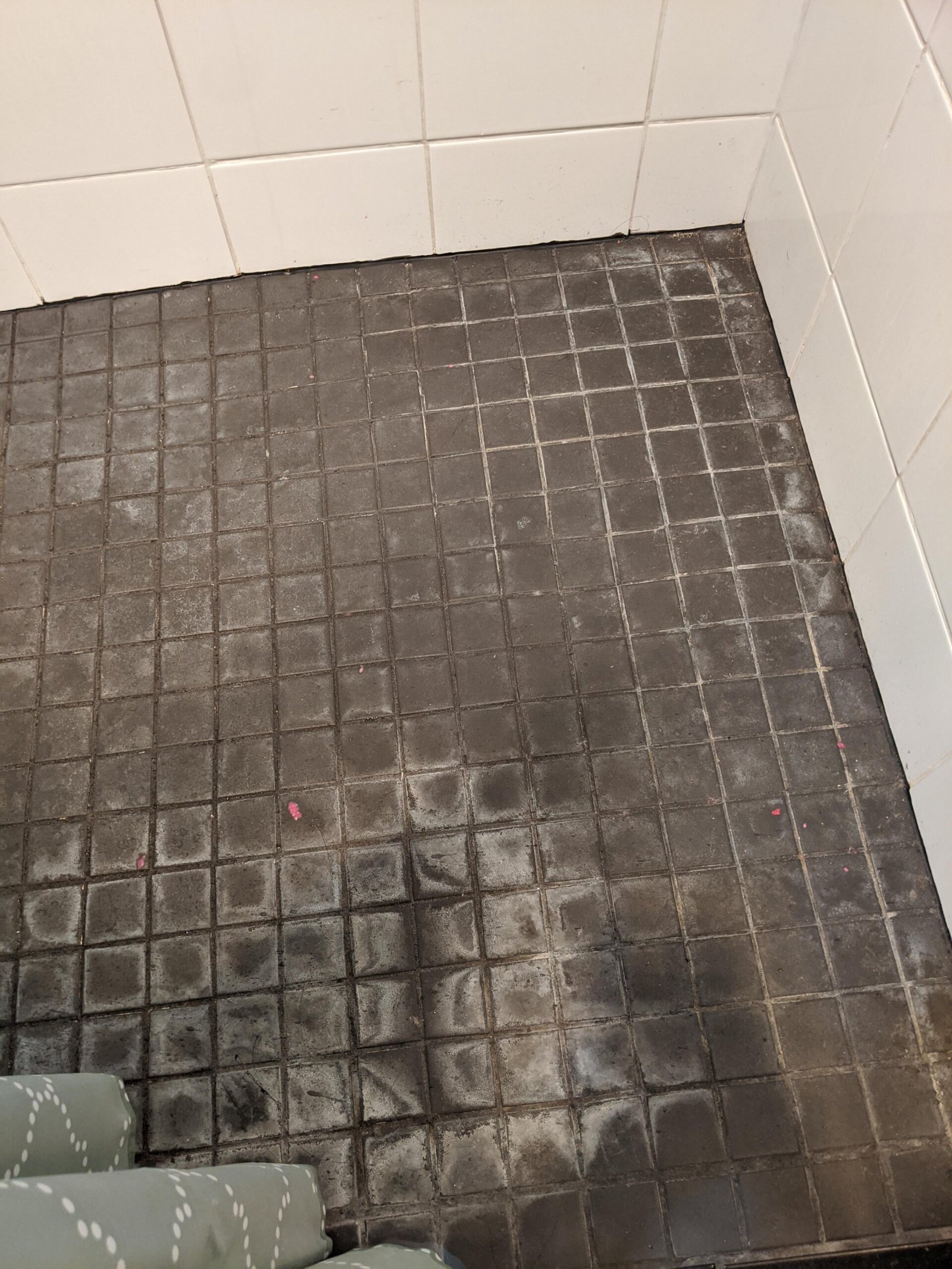Table of Contents
To clean calcium buildup on a shower floor, use a vinegar solution and a scrub brush. Let the solution sit for a few minutes before scrubbing.
Dealing with calcium buildup on your shower floor can be a frustrating task. This common problem often arises from hard water, leaving unsightly white or gray stains that can be tough to remove. Thankfully, with the right approach, getting your shower floor back to its original shine is achievable.
The key lies in using household items like vinegar, which is known for its natural cleaning properties, especially against mineral deposits. By applying this method, not only do you tackle the calcium buildup effectively, but you also opt for a safer, eco-friendly cleaning solution. This guide aims to equip you with a simple yet efficient technique to restore the beauty of your shower floor without resorting to harsh chemicals.

Introduction To Calcium Buildup
Calcium buildup on shower floors is a common household issue. This chalky, white substance is also known as limescale. It often forms when hard water evaporates, leaving behind minerals. These deposits can be tough to clean and may affect the appearance and function of your shower floor.
Common Causes Of Calcium Deposits
- Hard water with high mineral content
- Evaporation of water leaving minerals behind
- Infrequent cleaning, allowing buildup
Effects On Shower Floors
Calcium deposits can make shower floors look dull. They can also feel rough underfoot. Over time, these deposits may lead to permanent damage if not addressed. It is crucial to tackle calcium buildup promptly to maintain a clean and safe shower environment.
Identifying Calcium Buildup
Identifying Calcium Buildup is the first crucial step in tackling the unsightly white or grayish deposits that can make your shower floor look unclean. Knowing what you’re dealing with helps in choosing the right cleaning strategy.
Visual Characteristics
Calcium buildup, often known as limescale, has distinct visual characteristics. It appears as a hard, crusty deposit that clings to surfaces where water evaporates. On shower floors, these are typically white or grayish patches that are rough to the touch. Spotting these signs early makes removal easier.
- Hard, crusty texture
- White or grayish color
- Rough to the touch
Distinguishing From Other Stains
Distinguishing calcium buildup from other stains ensures you apply the correct cleaning method. Unlike soap scum, which is slippery and easier to wipe off, calcium deposits are hard and require specific cleaners or methods for removal.
| Stain Type | Texture | Cleaning Method |
|---|---|---|
| Calcium Buildup | Hard, crusty | Acidic cleaners, scrubbing |
| Soap Scum | Slippery, filmy | Mild detergent, wiping |
| Mold | Soft, fuzzy | Bleach, anti-fungal spray |
Preventative Measures
Tackling calcium buildup requires a proactive approach. Preventative measures can keep shower floors sparkling. Let’s explore effective strategies.
Regular Cleaning Routines
Maintaining a regular cleaning schedule is crucial. It prevents calcium deposits from hardening. Here’s a simple routine:
- Weekly scrubbing with a non-abrasive cleaner
- Dry the floor after each use
- Use a squeegee to remove water
These steps limit mineral buildup. They keep the shower looking fresh.
Using Water Softeners
Hard water contributes to calcium deposits. Water softeners can be a game-changer. They reduce minerals in water. Here are the benefits:
| Water Softener Benefits |
|---|
| Less calcium and lime scale buildup |
| Softer skin and hair |
| Longer-lasting appliances |
Install a water softener to fight hard water. Enjoy a cleaner shower floor.
Natural Cleaning Solutions
Natural cleaning solutions are safe and effective. They remove calcium buildup from shower floors. No harsh chemicals are needed. Homes often have these ingredients. They are vinegar, baking soda, and lemon juice.
Vinegar And Baking Soda Method
Vinegar is a powerful acid. It dissolves calcium deposits. Baking soda adds an abrasive element. Together, they work wonders.
- Mix equal parts of white vinegar and water in a spray bottle.
- Spray the solution onto the shower floor.
- Let it sit for 15 minutes.
- Sprinkle baking soda over the treated area.
- Scrub with a non-scratch sponge or brush.
- Rinse thoroughly with water.
Lemon Juice For Dissolving Calcium
Lemon juice is high in citric acid. It breaks down calcium naturally. It smells fresh and clean.
- Apply lemon juice directly to the affected area.
- Allow it to soak for 10 minutes.
- Scrub gently with a soft brush.
- Rinse well with cool water.
Chemical Cleaners And Safety
Chemical Cleaners and Safety play a crucial role in removing calcium buildup on shower floors. Choosing the right product and knowing how to use it safely ensures effective cleaning without harming your health or the environment.
Choosing The Right Product
Not all chemical cleaners are equal. Some are harsher than others. Look for products specifically designed to tackle calcium, lime, or rust. These are most effective against calcium buildup. Always check the label for suitability and environmental friendliness.
- Vinegar-based cleaners are mild and eco-friendly.
- Commercial lime and calcium removers pack more punch.
- For severe buildup, professional-grade products might be needed.
Proper Handling And Application
Chemicals, even household ones, require careful handling. Wear gloves and eye protection. Ensure the room is well-ventilated. Open windows or use an exhaust fan to avoid inhaling fumes.
- Read the product’s instructions carefully.
- Test on a small, inconspicuous area first.
- Apply the cleaner as directed, usually by spraying or pouring.
- Let it sit for the specified time to break down the calcium.
- Scrub gently with a non-abrasive pad if needed.
- Rinse thoroughly with water after cleaning.
Regular maintenance with the right chemical cleaner keeps shower floors free from calcium buildup. This routine ensures a clean, safe, and inviting shower space.
Mechanical Methods For Tough Stains
Stubborn calcium buildup on shower floors can resist typical cleaning methods. Mechanical approaches often provide the solution. These methods involve using tools to physically remove the buildup.
Pumice Stone Technique
Pumice stones are effective for tough calcium stains. They are natural, abrasive stones. They can scrape away calcium without damaging the shower floor.
- Soak pumice in water for 15 minutes.
- Wet the stained area.
- Gently rub the stone on the stain in circular motions.
- Rinse the area frequently to remove debris.
Always use pumice stones on wet surfaces. This prevents scratches. Test in an inconspicuous spot first.
Power Tools And Attachments
Power tools can tackle extreme buildup. They do the work fast and efficiently. Use power tools with caution.
- Choose the right attachment. Brush heads are best.
- Set the tool to a low-speed setting.
- Move the tool back and forth over the stain.
- Apply minimal pressure to avoid damage.
- Wipe and rinse the area clean.
Power tools should be a last resort. They can be harsh on surfaces. Always wear safety gear.
Post-cleaning Maintenance
Once you’ve tackled calcium buildup on your shower floor, it’s vital to keep it sparkling. Regular upkeep can prevent new stains and make cleaning easier. Let’s explore some effective maintenance habits to ensure your shower floor stays clean and clear.
Daily Drying Practices
Daily drying is essential to prevent calcium deposits. After each shower, use a squeegee or dry towel to remove water from the floor. This simple step stops mineral buildup and keeps the surface clean. Consider keeping a dedicated towel or squeegee nearby to make this a quick and effortless routine.
Sealing The Shower Floor
Protect your shower floor with a high-quality sealant. Sealants act as a barrier against water and minerals. They should be applied according to the manufacturer’s instructions. The right sealant can greatly reduce the frequency of deep cleans. Ensure the floor is completely dry before applying. Reapply sealant once a year, or as needed, to maintain its effectiveness.
Professional Cleaning And Restoration
Calcium buildup on shower floors can be stubborn. Sometimes, home remedies fail. This is where professionals step in. They use advanced techniques to restore your shower floor’s sparkle. Let’s explore when to seek their expertise.
When To Call The Experts
- Stubborn stains: When home cleaning fails.
- Discoloration: If the floor turns odd colors.
- Large areas: For extensive calcium buildup.
- Time-saving: Professionals work fast and effectively.
What To Expect From A Professional Service
A pro service brings back your shower floor’s shine. Here’s what they offer:
| Step | Action |
|---|---|
| 1. Assessment | They check the buildup extent. |
| 2. Cleaning | Pros use special tools and cleaners. |
| 3. Protection | They may apply sealants for future prevention. |
| 4. Maintenance Tips | Experts give advice to keep floors clean longer. |
A professional service leaves your shower floor looking new. Trust the experts for a deep, lasting clean.
Frequently Asked Questions
What Causes Calcium Buildup In Showers?
Calcium buildup on shower floors is primarily caused by hard water, which contains high levels of calcium and magnesium minerals. As water evaporates, these minerals are left behind, creating deposits.
How Can Vinegar Remove Calcium Deposits?
White vinegar, a natural acid, effectively dissolves calcium deposits. Apply it directly to the buildup, let it soak for a few minutes, then scrub and rinse away.
Are There Any Eco-friendly Cleaning Solutions?
Baking soda and lemon juice are eco-friendly alternatives that can be used to scrub away calcium buildup without harsh chemicals, making them safe for the environment and your home.
Can Calcium Buildup Damage Shower Floors?
Over time, calcium buildup can cause discoloration and deterioration of shower floor materials, potentially leading to costly repairs if not addressed regularly.
What Preventive Measures Reduce Calcium Buildup?
Installing a water softener, regularly drying the shower floor, and routine cleaning with mild acids like vinegar can greatly reduce the occurrence of calcium buildup.
Conclusion
Banishing calcium buildup from your shower floor can rejuvenate your bathroom’s sparkle. This guide has armed you with practical tips and natural solutions. Regular maintenance and our expert advice will keep those unsightly deposits at bay. Embrace these cleaning habits and enjoy a pristine shower that shines with cleanliness.
Your sanctuary awaits!

